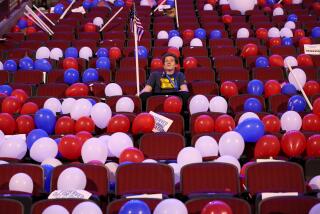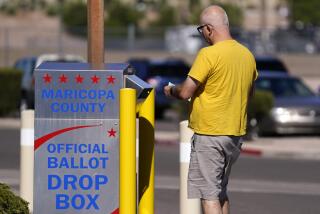A Rush to Judgment Doesn’t Serve the Needs of an Interested Electorate
- Share via
Admittedly it might be a bit of a stretch for either of the two stars. But if Hollywood were casting this year’s Republican presidential race, the ideal leads to play John McCain and George W. Bush would still be Jack Nicholson and Helen Hunt, because as U.S. politics goes, this really has been “As Good as It Gets.”
By any measure, the GOP race has been engaging, compelling and, on most days, enlightening. Turnout has shattered previous records in South Carolina, Michigan and elsewhere. Americans usually complain about lacking enough choices even after they’ve installed a 500-channel satellite television system, but in a national survey released Friday by Harvard University’s Vanishing Voter project, 85% of Republicans said they were satisfied with this year’s choice of candidates. And the same study shows voter interest in the primary steadily rising over the past month to a historic peak. “We are about as high as you can expect to go in a primary, period,” says Tom Patterson, a professor at Harvard’s Kennedy School, who directs the Vanishing Voter study.
And now, just as the country is really tuning in, the stampede of states to hold early primaries is about to close out the contest.
In the next nine days, 22 states will vote in a sea-to-sea blur of Republican primaries. More than half the total delegates to the GOP convention will be selected in this one spasm. By a week from Tuesday, it’s entirely possible--most analysts consider it likely--that the Republican nomination will be settled.
The Democratic National Committee tried to slow its race this year by barring primaries for the five weeks after New Hampshire. But that contest will almost certainly end this Tuesday because so many states (15 plus one territory) crowded their primary onto the first day the rules permitted--March 7.
The jarring conclusion looming over both contests is the result of a quarter-century process that has front-loaded presidential primaries into an ever-narrower window in February and early March. “I don’t see any advantage for voters in this,” says attorney Jim Roosevelt, the co-chair of a DNC panel studying the process. “They get less attention and are called on to give less attention.”
These costs have been most apparent in the GOP race, which has attracted more interest than the Democratic contest between Al Gore and Bill Bradley--indeed, more interest than any primary battle in years. This year’s early GOP primaries have proved that an exciting race could attract large numbers of voters back into the process--especially when candidates have enough time to court them at length. February’s gripping South Carolina Republican primary, in particular, demonstrated the potential for extended focus on a single state--Bush and McCain dueled there for 18 days--to not only generate enormous turnout locally but to crystallize the race in a way that engages the entire country.
Now, though, Bush and McCain face so many contests in such a short period that no state can receive more than glancing attention. In the final weeks before the vote, the California campaign has involved only a few days of jet-speed barnstorming and a single debate between Bush and McCain. New York has received even less attention. And in critical general election swing states such as Ohio, Missouri and Georgia that will vote Tuesday, the voters’ experience with the candidates this month was best described years ago by Bruce Springsteen: Just one look, and a whisper, and they’re gone.
It doesn’t have to be this way. In fact, it wasn’t always this way. As recently as 1984, the calendar stretched from February to June in a way that allowed for more considered evaluations of the candidates. In that year, the Democrats didn’t select half their delegates until 10 weeks after the New Hampshire primary, and Republicans until 11 weeks, political scientist William G. Mayer said. This year, both parties will cross the halfway mark on Saturday--less than six weeks after New Hampshire.
States moved up their contests mainly because they thought they would gain a larger say by elbowing to the front of the line. (Some party leaders have also encouraged the front-loading to resolve the race quicker, which usually benefits the front-runner.) But the result has been a frenzied process that reduces even the largest states to just one voice in the crowd and forces voters in most of the country to make snap judgments.
The good news is that commissions in both national parties are studying the problem--and planning to report by early May recommendations to slow the rush to judgment. Former Labor Secretary Bill Brock, who chairs the GOP commission, says a more staggered process, “is precisely what I am reaching for.” Roosevelt said the Democratic panel studying the problem is moving in the same direction. There’s even some hope the two groups may present joint recommendations to their parties by this summer.
The most frequently discussed alternative (promoted mostly by the National Assn. of Secretaries of State) would group the states into four regional primaries stretched over four months. But such a system would give an unfair advantage to a candidate who happens to be strong in the region voting first. Separating the primaries by a month would also ignore the lesson of February’s exhilarating GOP competition: a steady stream of contests sustains the story and builds voter interest.
A better alternative may be a plan offered by Delaware Republicans known as the “inverted pyramid.” It would allow states to hold primaries on separate days, but within designated one-month windows. To ensure the race isn’t decided too fast, it would permit only the smallest 10 states (by population) to vote in the first window, followed by the next smallest in the second, and so on. The most populous states couldn’t vote until the end--which would mean, in any competitive race, no candidate could amass a delegate majority at least until mid-May.
Like any such plan, this approach may have its own unintended consequences. But the consequences of inaction are plainly greater. If New Hampshire and Iowa can receive a year of attention, and South Carolina a month, voters in New York and California shouldn’t have to make their presidential choice based on a hurried week of low-content campaigning. This is the most powerful office in the world. What’s the rush?
*
See current and past Brownstein columns on The Times’ Web site at: https://www.latimes.com/brownstein.
More to Read
Get the L.A. Times Politics newsletter
Deeply reported insights into legislation, politics and policy from Sacramento, Washington and beyond. In your inbox twice per week.
You may occasionally receive promotional content from the Los Angeles Times.










